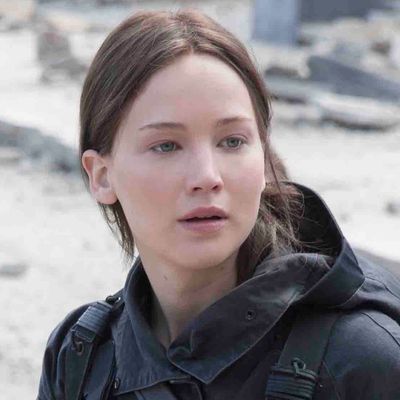
The final film adaptation of Suzanne Collins’s dystopian Hunger Games YA novels, Mockingjay — Part 2, is a potent antiwar saga: bleak, savage, and very modern in the depiction of an unholy union between political manipulation and showbiz. It’s impressive — but then, The Hunger Games is made of finer stuff than the standard fanboy-bait studio “franchises.” Maybe it’s that a woman wrote the books (although a woman also wrote the dumb, reactionary Divergent series, so go figure). These are war movies in which no victory is orgasmic: There are no exploding Death Stars, no triumphal processions, no propagandistic symbols that aren’t inherently suspect. All right, one climactic slaying has a satisfying thump, but otherwise, no one dies well. The heroine, Katniss Everdeen, is sickened by her warrior persona, the winged, black-clad “Mockingjay,” which is used as an icon of the rebel alliance like Delacroix’s painting of “Liberty” leading the French people at the barricades. To Katniss, killing is obscene, the upshot of a malevolent state that holds power by pitting citizen against citizen — and, most notoriously, in the annual Hunger Games, child against child.
Apart from adding a billion dollars to its coffers, Lionsgate had no reason to split Collins’s final book into two parts. (“Could there be a better reason?” you ask.) It takes a while for Mockingjay — Part 2 to recover the story’s momentum. It begins with Jennifer Lawrence’s Katniss in close-up, getting a brace taken off her bruised neck — the result of an attack by Peeta (Josh Hutcherson), the man she loves and whose life she saved, now brainwashed into wanting to kill her. Even if you don’t remember the end of Mockingjay — Part 1, the look on Lawrence’s face instantly establishes the overriding emotion: anguished incomprehension.
I can’t imagine how this role could be played more vividly. Lawrence’s performances in all four films — even the first, which was poorly directed by Gary Ross — have caught that distinctive “YA” element: the disconnect between Katniss’s inner world and how she’s seen by others. A film crew (led by Natalie Dormer) follows her into battle, broadcasting her moves in real time to the beleaguered outlying districts, firing up the citizens for the fight against the Capitol, District 1, home of a decadent elite and its mass-murderer president. But much of what Katniss does is stiff, her every “heroic” gesture freighted with self-consciousness. Like Lawrence herself, Katniss can’t play scenes she doesn’t believe. And though she knows what she’s fighting against — she thinks the mass-murdering President Snow (Donald Sutherland) is a fount of evil — she’s not sure what she’s fighting for. The president of the rebel alliance, Alma Coin, is played by Julianne Moore, with a white streak in her hair like Susan Sontag (or a skunk), and she’s all tight smiles and bland, canned rhetoric. Behind the scenes, she coolly plots with her consultant, Plutarch Heavensbee (Philip Seymour Hoffman), to exploit the Mockingjay symbol for all its worth. Who’s to say that the rebel leader is not President Snow’s mirror image?
The director, Francis Lawrence, has a heavy touch — but this is heavy stuff. Exteriors consist of either the rubbled remains of what were once homes for human beings or inhumanly huge squares that evoke Germany at its most fascistic. One long sequence takes place in a sewer in which the only living things besides the rebels are monsters that wipe out half the cast. Absent is anything green, anything organic. The Capitol’s super-capitalists have denuded the world.
Mockingjay suffers from two terrible casting decisions carried over from Ross’s first Hunger Games: Hutcherson, and Liam Hemsworth as Katniss’s hunky first boyfriend, Gale. The former is actually better than usual, hitting a couple of good, anguished notes as Peeta fights against his brainwashing. But his acting is still small-scale. As for Hemsworth, he’s hopeless; he makes a dull role duller. The love triangle doesn’t upstage the real story — a war being fought with bombs, bullets, and symbols — but it’s touch-and-go.
Mockingjay — Part 2 is all Lawrence, though a couple of others have their moments. As a ravaged former political prisoner given to mocking the Mockingjay, Jena Malone is — as usual — delightfully twisted: She kicks every movie she’s in into a queerer (in the old sense) gear. Embracing the chance to be illiberal, Sutherland relishes every hammy piece of villainy, and though Julianne Moore doesn’t rise above the material, her implacable glassiness has its charm. She’s the worst-case Hillary scenario.
The most problematic role is that of Philip Seymour Hoffman as the sly Heavensbee, not because he isn’t good but because he isn’t there for the second half, having died in the middle of shooting. Lawrence edits in reaction shots taken from other scenes (or other movies?) and, at the end, adds an obvious digital image. Showbiz trickery, however powerful, can’t yet reanimate the dead.
I’m not slighting Mockingjay — Part 2 when I say that it ends less with a bang than a whimper. There’s regrowth, but not enough — yet — to compensate for what’s gone. I wish every war movie ended on a note of loss, and maybe with more female writer-directors on the horizon (excluding Kathryn Bigelow, who gives men penis envy), more war movies will. In the meantime, this is the rare superhero saga in which the hero isn’t her true self until she can shed her costume and live in a world that has no need of symbols.


